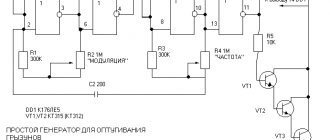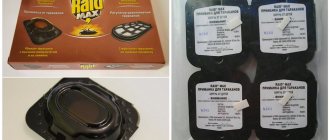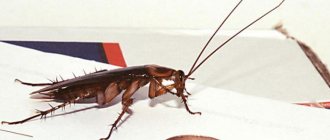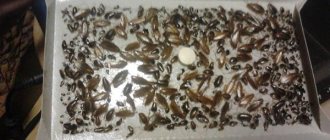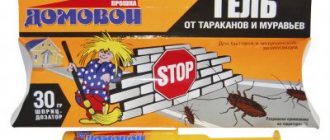Most people are afraid to face the problem of cockroaches in their apartment. Therefore, during renovations, you need to think through everything down to the smallest detail, including removing cockroaches, which may not be in your apartment now. But you should insure yourself as much as possible against their occurrence. You especially need to pay attention when renovating the kitchen. The kitchen is a favorite habitat for mustachioed pests. This place is dominated by a sufficient amount of water and food for cockroaches and their offspring, such as crumbs, quarrels on the floor, waste in the trash can.
Do not forget that cockroaches love to eat wallpaper and wallpaper glue, so during repairs it is worth adding poison to the glue or purchasing ready-made wallpaper glue for cockroaches at any hardware store.
DIY glue for cockroaches
Cockroaches have lived in the same home with people since ancient times. During this time, many different remedies and poisons for mustachioed “friends” were invented that can be added to wallpaper glue. Only a few effective recipes have survived to this day.
- Crayons. They are safe for human health and pets. They do not have a pronounced odor and do not leave marks on the wallpaper. The most popular is the “Mashenka” chalk.
- Dilute wallpaper glue as indicated in the instructions.
- The chalk needs to be finely scraped directly into the glue bucket. For one liter of glue, it is enough to use one fourth of the chalk.
- Mix the mixture thoroughly until the poison is completely dissolved.
- Wait 10 minutes and you can use the glue.
Cockroaches will not eat this glue; they sense the poison and are not comfortable being in such a room.
- Boric acid. Another secret when fighting cockroaches. If you add a small amount of boric acid to wallpaper glue, then cockroaches and bedbugs will never grow under the wallpaper. Boric acid is the main enemy of pests.
- Chlorophos. Many sources write that you can add 30-40g of chlorophos to a bucket of glue and then insects will refuse to visit your apartment. Chlorophos is a poisonous insecticide, so it must be stored in a place inaccessible to children and animals.
- Red pepper. You can add two bags of red pepper to the bucket of diluted glue. The product is effective, but many people refuse it because after the glue dries, bright spots may remain on the new wallpaper that will not please you at all.
How to make a cockroach trap with your own hands?
Making a cockroach trap with your own hands is not at all difficult. This will take a little time, and as materials you can use improvised means that can be found in any home. The design will depend on which version it is decided to produce. Some consider glue traps to be the most effective, while others prefer devices with poison.
Manufacturing
Set traps in places where cockroaches are most likely to appear - next to the trash can and sink, under the bathroom and cabinets, behind household appliances, along baseboards. It is best to set traps in the evening, since cockroaches are most active at night.
From a plastic bottle
You can make a cockroach trap from a plastic bottle with your own hands in just a few minutes. It is better to take a large bottle of 1.5 to 2 liters; it will make the trap more spacious. It is necessary to cut off the top of the bottle, measuring about a third of the entire length. Water is poured into the larger part to about half or a little less, bait is placed in the water. The walls of the bottle are greased from the inside (sunflower or olive oil, Vaseline are suitable).
Next, the upper part is inserted into the lower part so that the neck is directed downward. The joint can be taped with adhesive tape so that the parts do not move relative to each other. The principle of operation is simple - cockroaches will follow the smell, fall into the water, and will no longer be able to get out of the bottle. The disadvantage of such a trap is that the smell of the bait does not spread very well through the narrow neck, so it only attracts insects that are nearby.
From a cardboard box
Another simple and effective version of a cockroach trap that can be made at home is from a cardboard box. To work, you will need a cardboard box, double-sided tape and an odorous bait. To create the device, a pencil box is best suited.
The inner surface of the box is covered with double-sided tape, and the bait is placed in the center. Cockroaches follow the smell of the treat, crawl inside the box, stick and can no longer move. The box is convenient because when throwing it away, there is no risk of touching stuck insects. The design is in no way inferior in functionality to a purchased glue house.
From a glass jar
A very popular version of a homemade cockroach trap is using a glass jar. This option is more effective, since the aroma of the bait spreads better through the wide neck of the jar, which means it attracts more insects.
To make a cockroach trap at home, you will need:
- glass jar;
- paper or fabric;
- fat-containing product for lubricating the walls;
- bait.
From a glass jar
The inside of the jar is generously greased with vegetable oil or Vaseline. Bait is placed on the bottom. The outside of the jar is wrapped in paper or cloth to make it easier for insects to get up to the neck (you can simply glue a strip of cardboard or thick paper to the jar, which will become a convenient path for cockroaches).
Leave the jar in the kitchen or bathroom overnight. There is a high probability that many pests will be trapped in the trap in the morning.
Glue trap
You can even make an effective trap for cockroaches with your own hands from a box lid, a sheet of cardboard or thick paper. One side is covered with double-sided tape, and the bait is laid out in the center. Instead of tape, special glue “RaTrap” is often used, which can be purchased at hardware stores.
This is a special glue designed to combat insects and rodents. The substance is colorless and has no pronounced odor. The peculiarity of the glue is that it does not dry and has a long-lasting fixing effect. The product works equally well in dry and damp areas.
It is applied to the surface of cardboard, which is then placed under the refrigerator or furniture. You can make several traps and place them in the corners of the kitchen, next to the baseboards. Don't forget to put bait in the center of the trap.
By the way, prudent residents take measures to prevent the appearance of cockroaches even during the renovation process. They prepare poisoned glue for cockroaches with their own hands. To do this, before gluing the wallpaper, add boric acid or crushed Mashenka chalk to the wallpaper glue.
With boric acid
Self-made traps with boric acid differ from others in that with their help you can not only catch, but also destroy cockroaches. The substance acts on cockroaches from the inside, which means you need to make sure that the pest eats the poison. Since boric acid itself is tasteless and odorless, the powder is mixed with the cockroaches' favorite foods to make it attractive to insects. The most famous recipes with boiled yolk, boiled potatoes, minced meat.
Boric acid is mixed with the selected product (for uniformity, you can add a little vegetable oil or sour cream). Small balls are molded from the resulting mass, which will be used as bait. Poisoned balls can simply be placed in places where cockroaches accumulate, but placing them in traps will help enhance the effect.
It is very important to remember that water for cockroaches is truly a life-giving liquid. A poisoned cockroach, after drinking water, in most cases recovers. So, when laying out poisonous bait, you need to make sure that all access to water for insects is blocked. You should wipe the table and sink dry, remove or tightly close containers with water.
Electric trap
An electrical trap is a metal box containing uninsulated contacts and bait. The device is connected to the power supply, the cockroach crawls inside based on the smell and dies from the electric discharge.
Electric
You can make an electric trap for catching cockroaches at home, but to do this you need to have knowledge in electrical engineering and carefully follow safety measures in the process of both creating and operating the trap. Otherwise, it will not be the cockroaches who will suffer, but the apartment residents.
Specialized wallpaper glue for cockroaches
Not long ago, “Euro 3000 Extra” adhesive for vinyl wallpaper from PUFAS WERK went on sale. The glue contains synthetic resin and starch-containing powder with the addition of natural ingredients that have a detrimental effect on cockroaches and other insects. You can also find natural lavender extract in the composition, which helps fight moths.
The adhesive is designed for gluing different types of wallpaper:
- heavy;
- paper;
- vinyl;
- wallpaper for painting;
- with wood covering.
The glue is made from natural ingredients that do not harm the human body or pets. Therefore, you can use this glue without fear for your health and the health of your loved ones.
The glue is sold in powder form in small packs of 300 g. One box is designed for 4-6 liters of water. After you have mixed the powder with water, you need to stir the solution thoroughly so that there are no lumps and leave for a few minutes until the glue swells. One packet of powder is enough to cover 25-30 sq.m. wallpaper
Preparing the room before wallpapering
To effectively get rid of baleen insects, you need to prepare the walls before gluing the wallpaper.
- We remove the old wallpaper and immediately throw it away, as there may be unwanted “neighbors” lurking there.
- We get rid of adhesive paints and lagging layers of whitewash.
- Get rid of all debris in the room, wipe the floor and walls from dust with detergent.
- Fill all cracks and holes in the walls.
- Cover or foam all technical cracks that appeared during repairs.
- The walls should be treated with a solution of 72% laundry soap, soda and water. Laundry soap should be grated on a coarse grater, mixed with a spoon of soda and a liter of water. Use this solution to thoroughly wipe the walls and joints. After the walls have completely dried, you can begin gluing wallpaper.
General rules for using traps
Traps, regardless of design, are placed in places where cockroaches are most concentrated. Usually this is the kitchen (places under the sink and next to the trash can), bathrooms (under the bathtub, behind the toilet). Cockroaches also prefer to hide behind furniture, radiators and baseboards, so it is better to place traps closer to the walls.
The caught insects are most often killed with boiling water; it is not recommended to wash them down the sink or toilet with water - they can survive and return through the sewer pipes.
If there are a lot of cockroaches in the house, traps will noticeably reduce their number only after a few weeks, but these devices are unlikely to help catch all the insects. To completely and quickly remove cockroaches, it is best to combine traps with insecticidal agents (for example, crayons, aerosols), and also completely block the insects’ access to food and water: store food tightly packaged, keep the kitchen and bathrooms dry.
Cockroach glue “ALT”
This glue is used to create cockroach traps in various rooms.
ALT product is an adhesive mass, which does not contain substances harmful to the human body, does not cause allergies, and can only cause slight irritation upon contact. ALT is not an insecticide.
To make a trap you will need:
- Thick paper or cardboard measuring 10*15 cm.
- Brush for applying glue to paper.
- Ready-made glue for cockroaches ALT.
ALT solution is applied to the paper in a thin, even layer. Prepared traps are laid out in dark places and in places where cockroaches are most often found: next to baseboards, under the sink, in the bathroom, near pipes. If you need to place the paper in a vertical position, glue it to the wall with double tape. You can put bait on the leaves: a piece of bread or cookies. After filling the trap with cockroaches, you should throw it away and, if necessary, make a new one.
Types of cockroach traps and how they work
At the hardware store you can find a large selection of cockroach traps, each of which works according to a specific principle. Let's look at the most popular models.
Glue trap
The operating principle of all adhesive traps for cockroaches is based on fixing insects on a surface coated with an adhesive composition. Most often it is a cardboard box with holes on the sides. To encourage cockroaches to enter the box, bait is placed inside it. Insects are attracted by the smell, they make their way inside and stick to the bottom of the house. After most of the trap is filled, it should be thrown away and replaced with a new one.
Looking at such a trap when it is filled with insects is not the most pleasant experience. But since it contains no toxic substances, it is absolutely safe and can be used in any room. You need to place the “houses” where there is high activity of cockroaches - near the trash can, radiators, behind the stove, under the bathtub, and so on.
The disadvantage of the device is that it is ineffective against cockroach eggs and cannot cope with a large number of individuals.
Pros: ease of use, possibility of use in places where high safety requirements are imposed.
Electronic (electric) trap
Electric cockroach traps - a box with bait placed inside. From time to time the bait will need to be changed. The destruction of cockroaches occurs using a discharge of electricity. Also, the current discharge carries out disinfection; the bacteria that were on the insects die. Interestingly, a cockroach that dies in a trap releases a pheromone that attracts other cockroaches. From time to time, the corpses of Prussians need to be removed; a special brush is used for this. Since the device runs on electricity, you need to keep it away from curious children and make sure there is no moisture near it.
The disadvantage of the trap is its high cost.
Plus - the device is safe and durable.
Traps with insecticide
Poison traps are boxes with holes in which insecticidal bait is placed inside. Climbing out of the box, cockroaches spread the poison, infecting their relatives. Such traps can be mounted vertically thanks to Velcro. There are models that fit perfectly into the interior, so you don’t even need to hide them.
Pros: efficiency, convenience, affordable price.
